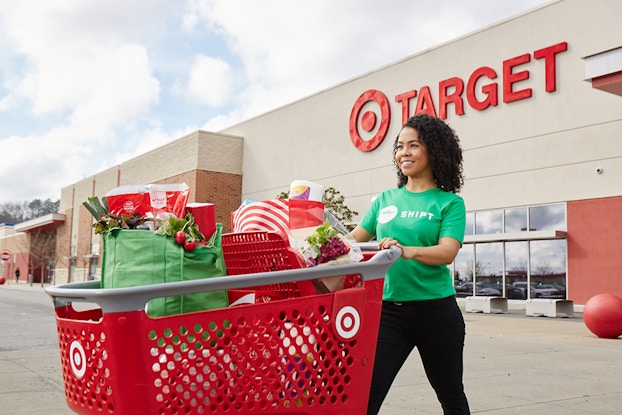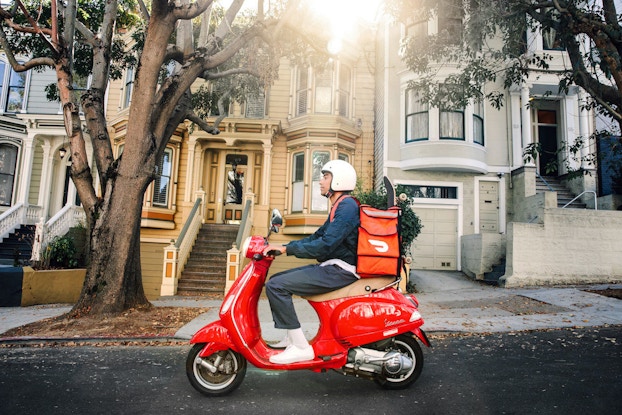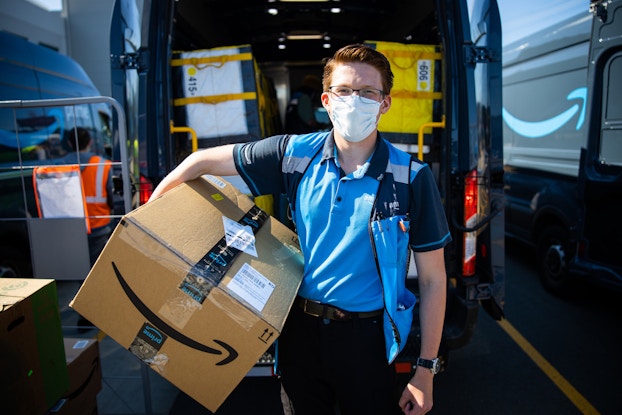
Why it matters:
- E-commerce sales grew more than 30% in 2020, and consumer expectations around rapid delivery have also increased.
- Retailers and brands may need to consider which products consumers are most likely to want quickly, and whether rapid fulfillment is worth the cost.
- Companies seeking to fulfill the last mile of delivery, such as DoorDash and Gorillas, are gaining traction either as standalone entities or as part of larger delivery networks, such as the Target/Shipt and UPS/Roadie acquisitions.
As e-commerce sales soared during the pandemic, so did consumer expectations around service levels, including same-day delivery for many products.
That has forced an evolution of the last-mile delivery landscape, as traditional shippers such as UPS and FedEx are challenged to keep pace with demand. New players offering same-day delivery, or delivery within minutes, are expanding by delivering household essentials to people’s homes, while some retailers and direct-to-consumer businesses are partnering with established delivery specialists and opening micro-fulfillment centers, as well as dark stores, that place their goods closer to consumers to achieve speedier service.
U.S. e-commerce sales reached $791.7 billion in 2020, up 32.4% over 2019 levels, according to the U.S. Department of Commerce, contributing to the extraordinary pressure on supply chains that is expected to continue into next year.
“E-commerce had already been growing … and then we saw what happened last year,” said Dave Glick, chief technology officer at Flexe, a provider of omnichannel logistics solutions. “This was bound to happen. It just happened a few years earlier than people expected.”
Retailers, brands and third-party delivery companies have all been exploring strategies to satisfy consumer demand for rapid fulfillment. For retailers with widespread presence such as Walmart, Target, discount retailers and food-and-drug chains, same-day delivery often involves simply using their stores as distribution hubs and partnering with third-party delivery providers such as DoorDash, Instacart or Uber.
In addition, a growing number of services offering delivery in as little as 10 or 15 minutes are expanding in the U.S., including companies such as Gopuff, which operates its own micro-fulfillment centers and buys groceries and other essential products directly from distributors. It employs its own pickers and works with independent delivery drivers. Other service companies in the ultra-fast space include Buyk, which offers 15-minute delivery via bicycle from its own network of dark stores, and Gorillas, a Berlin, Germany-based delivery company offering 10-minute delivery.

For small businesses and manufacturers that offer their products direct to consumers from a limited number of warehouses, however, speedy fulfillment of direct-to-consumer orders can be an onerous task.
Marc Palazzolo, strategic operations manager at consulting firm Kearney, said DTC brands and small businesses can consider shifting some inventory closer to their customers, for example by partnering with micro-fulfilment center providers such as Darkstore or AutoStore.
Such moves, while they might help satisfy consumer demand for speedy delivery, come with challenges, however, he said. For one thing, inventory management becomes more complex when it is spread out across multiple warehouses, Palazzolo said. In addition, manufacturers need to consider the capabilities of local delivery services, which may rely on a pool of gig workers who may or may not be able to fulfill orders in a desired time frame.
“That's an important consideration, because if you're not able to get orders filled, then you have more [customer experience] issues that come up,” said Palazzolo.
He said companies seeking to provide home delivery might want to survey their product offerings to determine which products their consumers are likely to want delivered quickly.
“You may not need a couch or your Peloton delivered in two hours,” he said. “My recommendation would be to take a customer perspective and say, ‘What products do customers want at what speeds?’ That's going to then dictate how you think about your network.”
Companies should also consider whether or not the profit margins on each product allow for the costs of rapid delivery, Palazzolo said.
You may not need a couch or your Peloton delivered in two hours. My recommendation would be to take a customer perspective and say, ‘What products do customers want at what speeds?’ That's going to then dictate how you think about your network.Marc Palazzolo, strategic operations manager, Kearney
New last-mile delivery players
Both Uber and Lyft last year launched on-demand parcel delivery for certain items, called Uber Connect and Lyft Deliveries, respectively, which leverage their fleets of independent drivers. In addition, DoorDash, which began as a third-party restaurant delivery service, last year launched a partnership with Macy’s that allows customers to get same-day delivery from more than 500 Macy’s and Bloomingdale’s stores around the country. The Macy’s partnership followed on the heels of similar DoorDash agreements with PetSmart, Walgreens, CVS, 7-Eleven, Wawa and Sam’s Club Pharmacy.
“Ultimately, our vision is to build the local, on-demand FedEx,” DoorDash states on its website. “We are a logistics company more so than a food company.”
Also last year, UPS acquired Roadie, a local parcel delivery specialist, to help it meet demand for same-day delivery. Roadie has a network of thousands of drivers nationwide that can be called upon to deliver parcels locally. It has partnerships with retailers such as bakery franchise Nothing Bundt Cakes, which rolled out Roadie’s delivery service last year at the height of the pandemic.
Those developments follow increasing efforts by retailers such as Target and Walmart to provide rapid local delivery to consumers from their stores and warehouses. Target in 2017 acquired its own last-mile delivery partner, Shipt, which had already established itself offering grocery delivery for supermarkets in several markets, and followed with the acquisition in 2020 of certain technology from Deliv, a provider of delivery-management solutions.
“Retailers are trying to scale up their ship-from-store, because I think there's a consensus that fast shipping is important,” said Glick.
That model can have some drawbacks, however, including inefficiencies from the delivery of mostly very small parcels, and also the fact that unlike warehouses and distribution centers, most stores were not designed for efficient picking, but instead were designed to encourage shoppers to buy more products.
“You have to walk past the beer to get to the diapers is the classic [example],” said Glick.
Retailers will need to make picking as efficient as possible if they are going to deliver from their stores, and that could require either rethinking their layouts or making more use of dark stores — either stand-alone facilities or attached to existing stores, he said.
“My recommendation is to [build] dedicated fulfillment centers in all of the NFL cities to do delivery in the same day, or next day, to 50% of your customers,” said Glick, referring to the markets around the country that have National Football League teams. However, “everybody wants to use the same inventory pool and use the same physical structures that they already have.”

Amazon expands local delivery solutions
Amazon, which has long shipped globally from its warehouses, has added services that help its small suppliers fulfill rapid local delivery requests as well. The company’s local selling solutions include buy online, pick up in store (BOPIS) as well as self-delivery if its local vendors choose to offer it.
Satish Jindel of SJ Consulting Group said Amazon is fast becoming a significant player in the distribution space, but other players such as DoorDash, Uber and Lyft are not having nearly as much of an impact.
“There are new attempts to get into last-mile delivery, but attempting is a far cry from disrupting someone,” he said. “They may get a few things here and there with their model, but UPS and FedEx aren’t worrying about them.
“Amazon is a different beast,” Jindel continued. “Amazon has [traditional carriers] shaking in their boots, but it’s not because they are disrupting, it’s because they are a retailer and a provider of service. They have captive business.”
Walmart could be in a similarly strong position at some point, he said, and Target has already taken steps in that direction.
Amazon stands to have an even bigger impact in the next few years, said Jindel. The company’s delivery vehicles, he said, are currently moving packages only from warehouses to customers, and then returning empty, which means they have excess capacity on the return trips — unlike UPS and FedEx, which deliver in both directions.
“Amazon will capitalize on it by getting into a full-service offering,” Jindel predicted. “Everything is in place; they just need to lay out the value proposition.”
CO— aims to bring you inspiration from leading respected experts. However, before making any business decision, you should consult a professional who can advise you based on your individual situation.
Follow us on Instagram for more expert tips & business owners’ stories.
CO—is committed to helping you start, run and grow your small business. Learn more about the benefits of small business membership in the U.S. Chamber of Commerce, here.

Interested in a small business membership?
Find out how the U.S. Chamber of Commerce can help your company grow and thrive in today's rapidly-evolving business environment. Connect with our team to learn how a small business membership can benefit your bottom line and help you achieve your goals.







